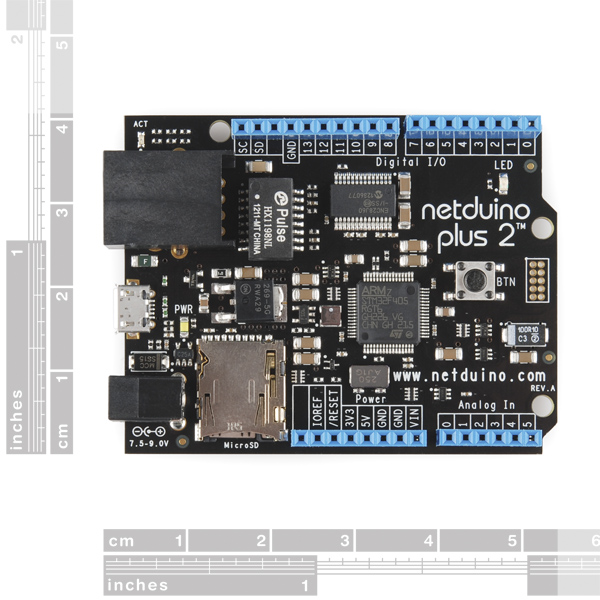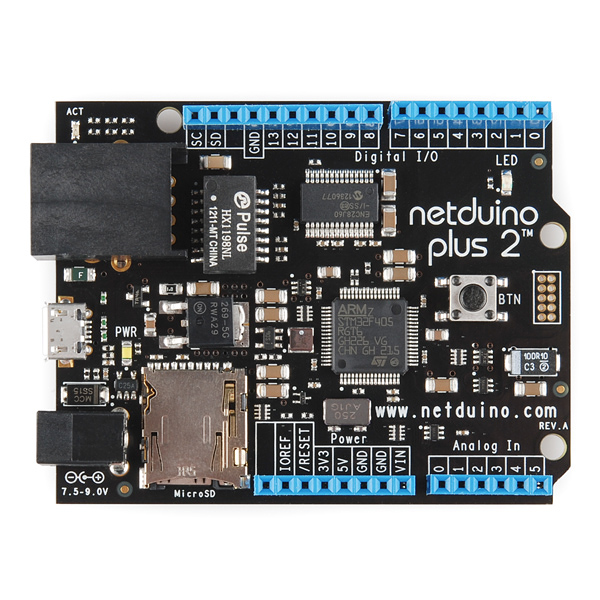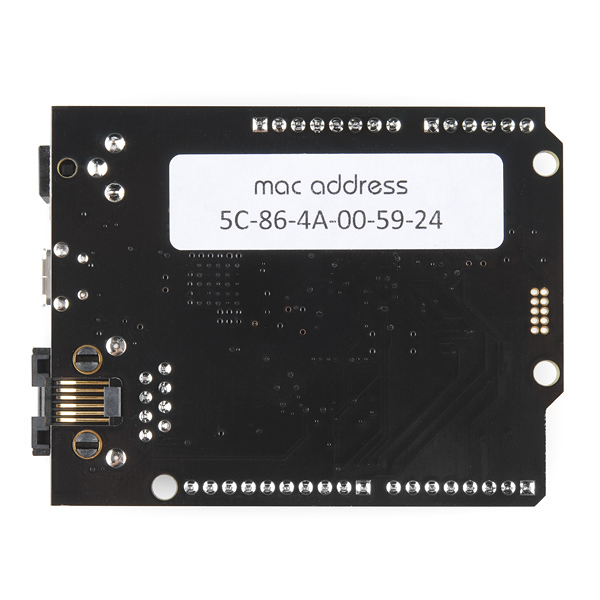Netduino Plus 2
The Netduino Plus is an open source electronics platform using the .NET Micro Framework. The board features a 32-bit microcontroller and a rich development environment, making it a perfect solution for engineers and hobbyists alike.
The Netduino Plus 2 has four times the speed (168MHz), six times the code space (384KB), and twice the available RAM (100KB+) of Netduino Plus 1. They've also given it a whole series of rich new features like four serial ports, six PWM channels and 12-bit ADC. The 6-pin ICSP header has been swapped out for a 10-pin MiniJTAG header. The goal is to enable developers to compile their own firmware using GCC and debug both native and managed code at the same time.
Replaces:DEV-10186
- STMicro 32-bit microcontroller
- Speed: 168MHz, Cortex-M4
- Code Storage: 384 KB
- RAM: 100+ KB
- 10 mbps Ethernet
- Micro SD card support up to 2 GB
- Input Voltage: 7.5 - 9.0 VDC or USB powered
- 25 mA per Pin max Current
- Digital I/O are 3.3 V but 5 V tolerant
- Schematic
- Layout File
- Datasheet (STM32F405RG)
- Reference Manual (STM32F405RG)
- .NET Micro Framework v4.2 Source
- Netduino Pus 2 Firmware v4.2.1 Source
- Product Page
Netduino Plus 2 Product Help and Resources
Core Skill: Programming
If a board needs code or communicates somehow, you're going to need to know how to program or interface with it. The programming skill is all about communication and code.
Skill Level: Competent - The toolchain for programming is a bit more complex and will examples may not be explicitly provided for you. You will be required to have a fundamental knowledge of programming and be required to provide your own code. You may need to modify existing libraries or code to work with your specific hardware. Sensor and hardware interfaces will be SPI or I2C.
See all skill levels
Core Skill: Electrical Prototyping
If it requires power, you need to know how much, what all the pins do, and how to hook it up. You may need to reference datasheets, schematics, and know the ins and outs of electronics.
Skill Level: Noob - You don't need to reference a datasheet, but you will need to know basic power requirements.
See all skill levels
Comments
Looking for answers to technical questions?
We welcome your comments and suggestions below. However, if you are looking for solutions to technical questions please see our Technical Assistance page.
Customer Reviews
5 out of 5
Based on 1 ratings:
1 of 1 found this helpful:
One of the best board i know
As a .Net programmer, to use the language and the environment where I work every day makes it much easier the development of prototypes of various projects. The ethernet and the SD card on board are a Plus!






Hi guys, any idea when these will be back in stock?
Sorry if this is obvious to others, I'm a little confused about the product description stating "goal is to compile using GCC" - I thought the Netduino is for Visual Studio .NET - does this mean that this is for .NET coders to get started with .NET then move to GCC? I'm a little confused about this. Thank you
Is the rating "10 mbps Ethernet" as printed or is it a typo and should read "10/100 mbps Ethernet" which is most common?
it IS 10 mbps only, and 100 isn't supported. Had an issue at work where the switch wasnt set up to handle 10 mbps traffic and I couldn't see the device at all. Major heart attack moment there.
Surprisingly, I believe it's correct. The schematic shows that it uses the ENC28J60 Ethernet controller [Datasheet] which is 10BASE-T. The original Netduino Plus used a different controller (the DM9161AEP [Datasheet]) which supported 10/100 Mbps.
Apparently you can also get them from SparkFun.